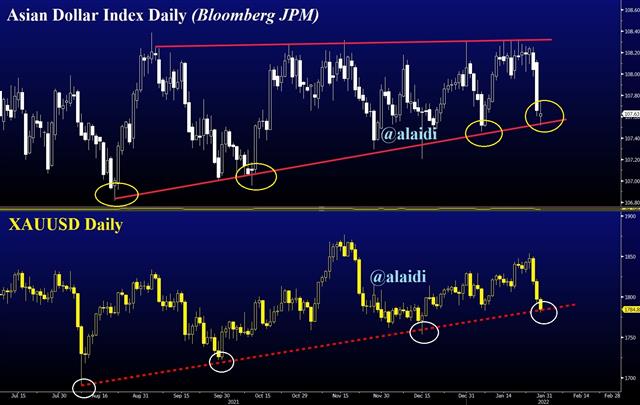Just as you become more certain the US dollar will go nowhere but up, you stumble into this analysis, suggesting other ideas. No, this is not a piece explaining the Fed's inability to deliver the four or five rate hikes that are priced in, nor it's about other central banks having to join the Fed. Ok, maybe both of those are true...
While most USD charts (DXY, Fed, and Bloomberg's USD indices) show robust upside ahead, the Asian Dollar Index (below) highlights ongoing support in Asian currencies (or USD facing resistance vs. Asian FX). Unlike DXY and FRB's index, the ADXY is not skewed by ultra dovish monetary policies of the Eurozone or Switzerland.

Just as you become more certain the US dollar will go nowhere but up, you stumble into this analysis, suggesting other ideas. No, this is not a piece explaining the Fed's inability to deliver the four or five rate hikes that are priced in, nor it's about other central banks having to join the Fed. Ok, maybe both of those are true...
While most USD charts (DXY, Fed, and Bloomberg's USD indices) show robust upside ahead, the Asian Dollar Index (below) highlights ongoing support in Asian currencies (or USD facing resistance vs. Asian FX). Unlike DXY and FRB's index, the ADXY is not skewed by ultra dovish monetary policies of the Eurozone or Switzerland.
I bring this up now due to the Asian index's (ADXY) ability to proxy a crucial trading bloc with more weighting in the Chinese yuan. The ADXY even helped me clarify how/why the US dollar was gaining in the past simultaneously alongside gold.
We could well see gold extend to $1770 or $1760 next week and ADXY extending weakness to 107.00, but traders ought to remember the difference between closing and intraday lows. Add to this that demand/supply inflationary forces may likely overwhelm timid rate hikes from the Fed (especially when Fed plans to let assets roll off rather than selling them), and gold will have more breathing room than in the tightening cycles of 2015 or 2018. Stay tuned.

